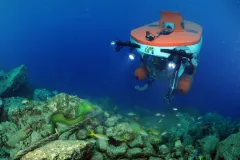Keeping Exploration Alive With Manned Submersibles

The Ocean Portal was lucky enough to join the Deep Reef Observation Project team in Curaçao where they explore deef reefs in a manned submersible (the Curasub). Recently, talk in a variety of places has questioned whether scientists should study the deep sea by traveling there themselves in manned submersibles, or if robots should lead the charge instead. We talked to Carole Baldwin, the principal investigator of the Deep Reef Observation Project, about why manned submersibles are so important for exploring the deep ocean. Here's her response:
Manned submersibles allow the scientists to get down there in the environment to observe the life in its natural habitat, and actually make collections. Most of the little robots, the ROVS (Remotely Operated Vehicles), that are tethered and sent down from a ship are fantastic! They allow for a lot of wonderful photography and video. I think actually what we need from a science perspective is both the robots and the manned submersibles in tandem. The robots can go further and, with a lot less cost, allow you to map out what's down in the deep—the ecosystems and habitats. But you need that manned submersible to actually go down and make the collections, and decide what you want to collect. They are more expensive and that is one of the reasons that manned submersible technology is being phased out in many places. But the cost is, for example, a fraction of what we pay for every space expedition. This is our own planet and we know so little about it, so I think the justification for it [manned submersibles] is there.
You can see more about what it's like to dive in a submersible and our trip to Curaçao.

